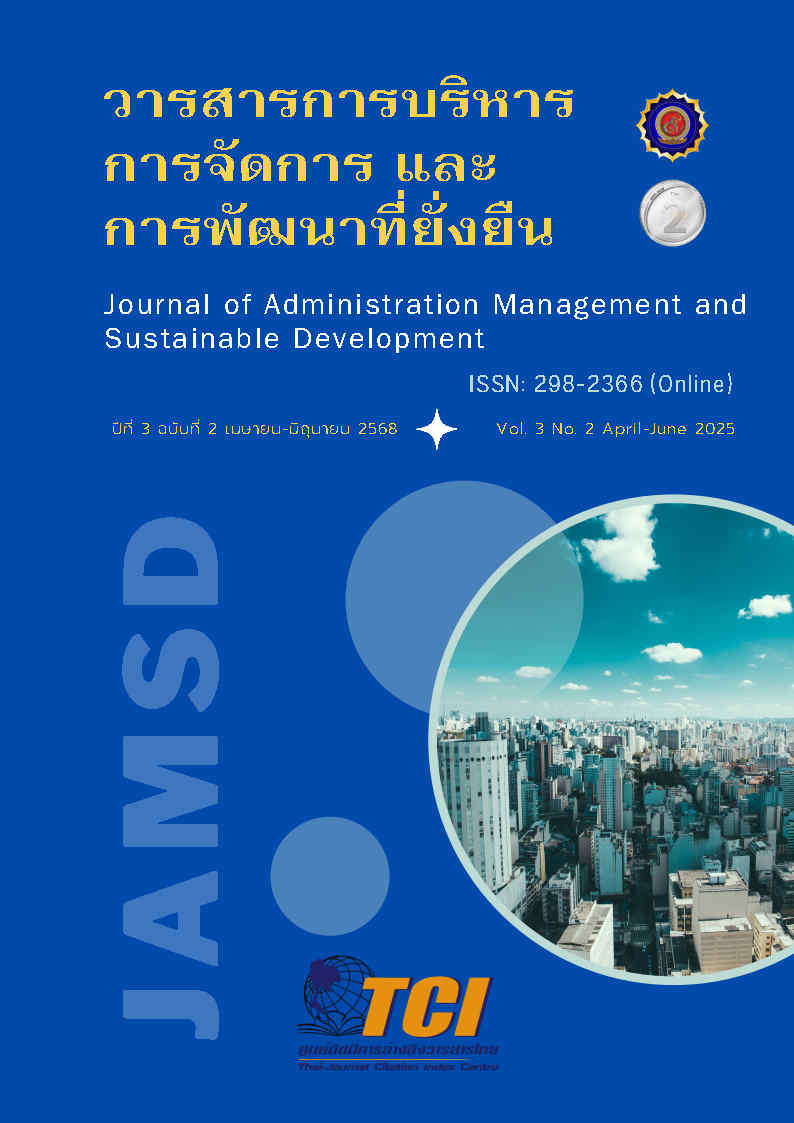Marketing mix Strategy for competitive advantage in ready mixed concrete business of Center Pro Concrete company in Uon Thani province
Keywords:
marketing-mix strategy, competitive advantage, ready mixed concrete businessAbstract
This research aimed to examine the marketing mix strategy influencing competitive advantage based on customer orientation of ready-mixed concrete customer business, Center Pro Concrete Co., Ltd., in Udon Thani Province and investigate participants’ perceptions of such factors. Data were collected using 96 sets of questionnaires from a sample group consisting of the company's customers in Udon Thani Province. The sample was selected using a non-probability sampling method through a convenience sampling technique. The data were analyzed using descriptive statistics with frequency, percentage, mean, and standard deviation and inferential statistics using multiple regression analysis at a confidence level of 95%. The findings indicate that physical is the most significant marketing-mix strategy influencing the customer-orientation-based competitive advantage, compared to other factors, followed by the opportunity for entrepreneurship and service. Additionally, the analysis of the relationships between the variables reveals that the factors affecting the customer orientation-based competitive advantage, with a significant level of 0.05, were place, promotion, and physical evidence.
References
เกริกฤทธิ์ อินแถลง และธนกร สิริสุคันธา. (2565). ส่วนประสมทางการตลาดที่มีต่อความพึงพอใจในการใช้บริการธุรกิจคอนกรีตผสมเสร็จในเขตอำเภองาว จังหวัดลำปาง. วารสาร มจร อุบลปริทรรศน์, 7(1), 561–574. https://so06.tci-thaijo.org/index.php/mcjou/article/view/255460.
ชลวิทย์ วรรณโชติผาเวข. (2560). ปัจจัยที่มีผลต่อความพึงพอใจในการซื้อคอนกรีตผสมเสร็จ. การค้นคว้าอิสระบริหารธุรกิจมหาบัณฑิต มหาวิทยาลัยธรรมศาสตร์.
บุญชม ศรีสะอาด. (2535). การวิจัยเบื้องต้น. กรุงเทพฯ: สุวีริยาสาส์น.
สืบชาติ อันทะไชย (2556). การบริหารการตลาด. กรุงเทพฯ: โอเดียนสโตร์.
Caliskan, A., Özkan Özen, Y. D., & Ozturkoglu, Y. (2021). Digital transformation of traditional marketing business model in new industry era. Journal of Enterprise Information Management, 34(4), 1252–1273. https://doi.org/10.1108/JEIM-02-2020-0084.
Cui, Y. (Gina), van Esch, P., & Phelan, S. (2024). How to build a competitive advantage for your brand using generative AI. Business Horizons, 67(5), 583–594. https://doi.org/10.1016/j.bushor.2024.05.003.
Dadzie, K. Q., Amponsah, D. K., Dadzie, C. A., & Winston, E. M. (2017). How Firms Implement Marketing Strategies in Emerging Markets: An Empirical Assessment of The 4A Marketing Mix Framework. Journal of Marketing Theory and Practice, 25(3), 234–256. https://doi.org/10.1080/10696679.2017.1311220.
Dung Ngo, V., Leonidou, L. C., Janssen, F., & Christodoulides, P. (2024). Export-specific investments, competitive advantage, and performance in Vietnamese SMEs: The moderating role of domestic market conditions. Journal of Business Research, 170, 114315. https://doi.org/10.1016/j.jbusres.2023.114315.
Ghezali, F., & Boudi, A. (2021). The moderating effect of information technology capabilities on the relationship between marketing mix and corporate entrepreneurship. PSU Research Review, 5(2), 101–119. https://doi.org/10.1108/PRR-12-2019-0037.
Grönroos, C. (2020). Viewpoint: service marketing research priorities. Journal of Services Marketing, 34(3), 291–298. https://doi.org/10.1108/JSM-08-2019-0306.
Hajjat, M. M. (2002). Customer orientation: construction and validation of the CUSTOR scale. Marketing Intelligence & Planning, 20(7), 428–441. https://doi.org/10.1108/02634500210450864.
Hossain, M. A., Agnihotri, R., Rushan, M. R. I., Rahman, M. S., & Sumi, S. F. (2022). Marketing analytics capability, artificial intelligence adoption, and firms’ competitive advantage: Evidence from the manufacturing industry. Industrial Marketing Management, 106, 240–255. https://doi.org/10.1016/j.indmarman.2022.08.017.
Ivy, J. (2008). A new higher education marketing mix: The 7Ps for MBA marketing. International Journal of Educational Management, 22(4), 288–299. https://doi.org/10.1108/09513540810875635.
Kwan, Y. K. C., Chan, M. W., & Chiu, D. K. W. (2023). Youth marketing development of special libraries in the digital era: viewpoint from the Taste Library with 7Ps marketing mix. Library Hi Tech, 42(6), 1740-1759. https://doi.org/10.1108/LHT-03-2023-0129.
Lim, W. M. (2021). A marketing mix typology for integrated care: the 10 Ps. Journal of Strategic Marketing, 29(5), 453–469. https://doi.org/10.1080/0965254X.2020.1775683.
Liu, Y., Mayerhofer, T. J. H., Marchand, A., Foscht, T., Fritze, M. P., & Eisingerich, A. B. (2024). Is there a danger of making customers feel too empowered? Exploring the double-edged sword of customer orientation and creative benefits. European Journal of Marketing, 58(11), 2393-2425. https://doi.org/10.1108/EJM-12-2021-0925.
Mahajan, P., & Golahit, S. (2020). Service marketing mix as input and output of higher and technical education: A measurement model based on students’ perceived experience. Journal of Applied Research in Higher Education, 12(2), 151–193. https://doi.org/10.1108/JARHE-01-2019-0022.
Modi, P., & Sahi, G. K. (2024). Balancing customer and employee orientations: impact on financial distress and firm value. Marketing Intelligence and Planning, 42(8), 1353–1383. https://doi.org/10.1108/MIP-12-2023-0664.
Navarro-García, A., Ledesma-Chaves, P., Gil-Cordero, E., & De-Juan-Vigaray, M. D. (2024). Intangible resources, static and dynamic capabilities and perceived competitive advantage in exporting firms. A PLS-SEM/fsQCA approach. Technological Forecasting and Social Change, 198, 123001. https://doi.org/10.1016/j.techfore.2023.123001.
Olsen, L. L., Witell, L., & Gustafsson, A. (2014). Turning customer satisfaction measurements into action. Journal of Service Management, 25(4), 556–571. https://doi.org/10.1108/JOSM-01-2014-0025.
Othman, B. A., Harun, A., De Almeida, N. M., & Sadq, Z. M. (2021). The effects on customer satisfaction and customer loyalty by integrating marketing communication and after sale service into the traditional marketing mix model of Umrah travel services in Malaysia. Journal of Islamic Marketing, 12(2), 363–388. https://doi.org/10.1108/JIMA-09-2019-0198.
Papadas, K. K., Avlonitis, G. J., Carrigan, M., & Piha, L. (2019). The interplay of strategic and internal green marketing orientation on competitive advantage. Journal of Business Research, 104, 632–643. https://doi.org/10.1016/j.jbusres.2018.07.009.
Pekovic, S., & Rolland, S. (2016). Customer orientation and firm’s business performance: A moderated mediation model of environmental customer innovation and contextual factors. European Journal of Marketing, 50(12), 2162–2191. https://doi.org/10.1108/EJM-08-2015-0584.
Porter, M. E. (1990). The competitive advantage of nations. Free Press.
Singh, R., & Koshy, A. (2012). A new conceptualization of salesperson’s customer orientation: Propositions and implications. Marketing Intelligence and Planning, 30(1), 69–82. https://doi.org/10.1108/02634501211193921.
Thoumrungroje, A., & Racela, O. C. (2022). Innovation and Performance Implications of Customer-Orientation across Different Business Strategy Types. Journal of Open Innovation: Technology, Market, and Complexity, 8(4), 178. https://doi.org/10.3390/joitmc8040178.
Woehler, J., & Ernst, C. (2023). The importance of marketing mix planning and customer orientation for venture capital–financed startups: impacts on valuation, performance, and survival. Journal of Research in Marketing and Entrepreneurship, 25(1), 1–25. https://doi.org/10.1108/JRME-08-2021-0098.






